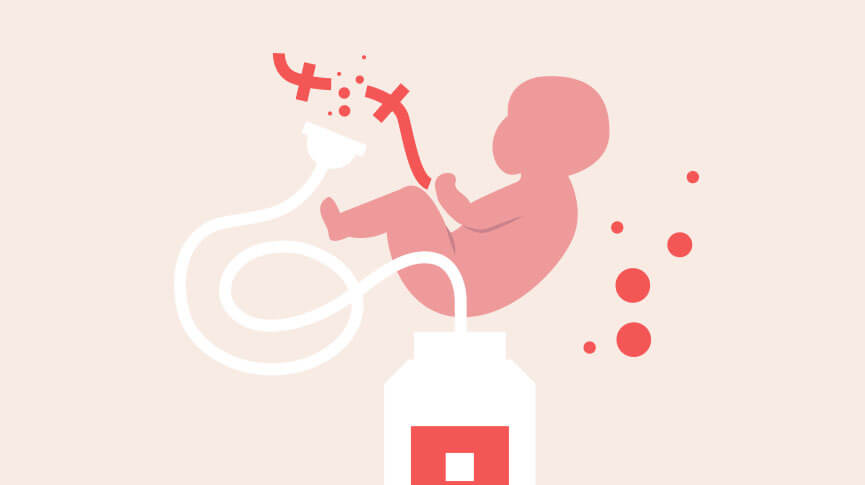Postpartum Prep: What is Cord Blood Storage?

As you move towards the end of your pregnancy you start to prep for labor and birth, exploring topics like what to pack in your birth bag and whether you should hire a doula. You’re also probably exploring what your options are when it comes to the physical support of you and your baby. For some people that might mean getting an epidural, while for others it could mean having a water birth. One birth topic that is starting to pop up on more and more people’s radars’ is cord blood storage. If this is totally new to you, no worries, we’re here to shed some light on this fairly new innovation in postpartum technology and its future uses.
What is Cord Blood?
Before we explain cord blood, let’s do a quick refresher on pregnancy anatomy. Your growing baby lives inside the amniotic sac in your uterus. Your baby’s umbilical cord attaches to what will be their belly button, and on the other side – the placenta. The other side of the placenta then attaches to the uterus. The placenta is what supplies your baby with vital nutrients and oxygen, along with a few other important roles. It also helps with blood circulation in both the pregnant person and the fetus.
The blood that’s found in the placenta and umbilical cord after birth is what we call cord blood. In this cord blood, you’ll find hematopoietic stem cells. These are specialized stem cells that can mature into other types of blood cells. You can also find these cells in the bone marrow and blood of people of all ages. You might be starting to get an idea of just why people practice cord blood storage.
Why Do People Practice Cord Blood Storage?
Cord blood is typically discarded along with the placenta and umbilical cord after birth. It can be collected whether someone has a vaginal or cesarean birth. Your provider typically uses a kit provided from a cord blood storage bank and uses a needle to draw out the blood from the cut umbilical cord. This is collected in a bag before being sent to the storage bank. More and more commonly, people are choosing to store or donate this cord blood for medical applications. Cord blood storage, also known as ”Cord blood banking”, has the potential for many incredible medical advancements. While other kinds of cells can replicate themselves, they’re typically limited to what they already know. For example, skin cells can only make more skin cells.
That’s what makes hematopoietic cells so special. Their ability to mature into different types of cells throughout the body. Thanks to hematopoietic’s versatile possibilities, these blood cells can be used to treat more than 70 types of diseases.
What Are The Benefits of Cord Blood Storage?
These are just a handful of the diseases that cord blood may be able to be used to treat:
- Leukemia
- Metabolic disorders
- Immune disorders
- Anemia
- Neurologic disorders
Newer research is looking into the possibilities of using cord blood for regenerative medicine which aims to stimulate the patient’s body’s ability to repair its own system. Regenerative medicine may be able to treat conditions like cerebral palsy and autism.
You might be wondering why providers would use cord blood from a baby when it can be retrieved from a grown person’s bone marrow. There are quite a few advantages to this. For one, stem cells that are collected directly after birth haven’t aged or been exposed to diseases that can impact their viability later in life. While bone marrow donation can be a painful and invasive procedure, cord blood is not. It’s simply collecting the blood from the umbilical cord after it’s been cut. If cord blood is used to treat a blood relative (like a sibling), transplants tend to be about twice as successful compared to a donation from a non-relative.
If a person has a condition like cancer, then their bone marrow can stop making healthy stem cells. Furthermore, treatments like radiation and chemotherapy can kill healthy stem cells. This is a real-life example of the importance of cord blood.
Are There Risks to Cord Blood Storage?
There are no known risks to the baby since the cord blood is collected after the umbilical cord is cut. Some people who wish to practice delayed cord clamping may not be able to collect cord blood. One obvious risk of cord blood storage is the potential financial strain. After the initial costs of medical care during birth, you also have to pay a storage fee for the cord blood, which varies depending on where you live. The chances that a baby or family member will actually need the stored cord blood are about 1 in 2,700. Given these slim chances, it’s up to the family if it’s worth it to pay the storage fee for the low chance of potentially providing life saving care. Even with cord blood collected, it may not contain enough stem cells neecessary to provide treatment, especially if the transplant is for an adult.
Cord Blood Storage and Donation
If you’re interested in storing your baby’s cord blood, you can discuss your options with your medical provider. Choosing to store your cord blood can be part of your birth plan. In many countries you can also choose to donate your cord blood to a public cord blood bank where it is used for research or to treat other people in need of stem cells. There are strict safety standards used for when overseeing the collection and storage of cord blood donation.

Natasha (she/her) is a full-spectrum doula and health+wellness copywriter. Her work focuses on deconstructing the shame, stigma, and barriers people carry around birth, sex, health, and beyond, to help people navigate through their lives with more education and empowerment. You can connect with Natasha on IG @natasha.s.weiss.


